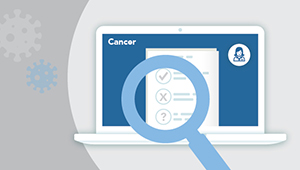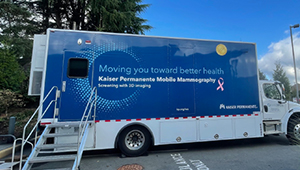Exploring the promise of at-home cervical cancer screening

Kaiser Permanente is at the forefront of research to increase screening rates by using home tests for HPV, a leading cause of cervical cancer
By Diana Buist, PhD, MPH, Senior Investigator, Kaiser Permanente Washington Health Research Institute
Scientific breakthroughs in cancer screening have saved countless lives over the past several decades. But sometimes the biggest barrier to effective cancer screening isn’t science — it’s what people have to do to get screened.
Take cervical cancer screening. Nearly all cervical cancers can be prevented by identifying and removing precancers caused by certain high-risk strains of the human papillomavirus, or HPV. But despite how successful screening has been at reducing deaths from cervical cancer — leading to more than 50% fewer cases in the last 40 years — screening rates are declining across the United States. One in 4 women don’t receive regular screenings, and half of all diagnosed cervical cancers occur in women who are not screened.
When asked why they miss cervical cancer screenings, many people say they find them uncomfortable, embarrassing, and difficult to schedule. They also cite barriers such as lack of time and transportation to get to screening appointments.
Could we save more lives by offering an easier screening option? Researchers at Kaiser Permanente and other institutions are on a journey to find out. And what we’re learning could change the landscape of cervical cancer screening for patients everywhere.
What if cervical cancer screening could happen at home?
Most people have heard about at-home test kits for colorectal cancer screening. Research at Kaiser Permanente has shown that mailing these kits is an effective way to boost colorectal cancer screening rates. With that as a model, Kaiser Permanente conducted a study including 16,590 women age 30 to 65 to explore whether at-home testing for HPV could be an effective way to increase screening for cervical cancer as well.
The home kits include everything a patient needs to collect a sample swab of vaginal cells to be tested for the HPV strains most likely to cause cervical cancer. Because of Kaiser Permanente’s integrated model, we were able to do our research alongside our normal care delivery. The patients returned their samples directly to our lab, and received results and follow-up care just like patients who had been screened in one of our clinics. Our research showed that samples collected at home detect HPV just as well as samples collected by a clinician.
Next, we examined the response rate when we mailed HPV testing kits to a sample of women who were overdue for cervical cancer screening. We found that mailing HPV kits increased screening by more than 50% compared to standard care. A follow-up survey showed that the women who returned the kits had very positive feelings about the experience.
Among the women who did not return the kit, the most common reasons were feeling unsure about how to use it correctly and not understanding why screening was necessary. This showed us that future outreach efforts should do a better job of explaining how the home HPV test kit works and what the results mean, in addition to explaining why getting screened is still important for people who have received their HPV vaccination, are monogamous, or are no longer sexually active.
We are working on addressing these barriers in an ongoing follow-up trial of 33,000 women. The study explores different outreach approaches based on participants’ prior screening behavior. It also tests different educational strategies to evaluate whether the information we provide can motivate individuals to get screened.
What’s next?
Although home HPV testing is used in several other countries, the kits have not yet been approved by the U.S. Food and Drug Administration for cervical cancer screening. Research like ours is providing important data that can help pave the way for their approval in the U.S.
Making at-home HPV testing kits widely available, while still in the future, could give women a choice they’ve never had before. For some, that choice could save their lives. But it’s a choice that needs to come with the right amount of information at the right time.
Learn more about cancer care at Kaiser Permanente.
Healthy Findings Blog

Cancer screening in the time of COVID-19
Dr. Diana Buist reflects on the challenges of providing screening during a pandemic — and finds reason for optimism.
Immunizations

HPV, get vaccine!
From the archives: Our music video on the HPV vaccine is just as timely (and catchy) as ever.
Healthy findings blog

Prioritizing breast screening during COVID-19
As cancer screening rates rebound, Erin Bowles, MPH, reflects on maintaining “pink ribbon” awareness year-round.


